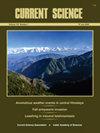Evaluation of distilled water as a mountant in the slide preparation for phytolith identification
IF 1
4区 综合性期刊
Q3 MULTIDISCIPLINARY SCIENCES
引用次数: 0
Abstract
: Microscopy is a critical component in phytolith research. To identify and count distinct morphotypes, phytoliths extracted from sediments are put on microscopy slides and observed under a microscope. The mounting material used to adhere the samples to the slides has an effect on visibility and image quality. Mountants are chosen depending on whether a temporary slide is required or a permanent one. Benzyl benzoate, microscopy immersion oil, glycerol and distilled water are few temporary mountants used for phytolith analysis. This paper evaluates the efficiency of distilled water as a temporary mountant with regard to viewing efficiency, image clarity and ability of rotation of phytoliths. Grade 1, English glass) on it. The prepared slides are observed using bright field microscope (Leitz- Laborlux 12 Pol-D) at a magnification of 250x. To qualitatively differentiate the efficacy of different mountants; experimental samples are prepared using Canada Balsam, Benzyl Benzoate, Glycerol, Microscopy Immersion Oil and distilled water (laboratory grade). Canada balsam is included in the experiment, though it is a permanent mountant, as it does not solidify for 24-48 hours, thus allowing movement of phytoliths for observation. Both dry samples as well as samples which had some moisture in them are used in the experiments.蒸馏水在植物体鉴定载玻片制备中用作载玻片的评价
显微镜是植物岩研究的一个重要组成部分。为了鉴定和计数不同的形态,从沉积物中提取的植物岩放在显微镜载玻片上,在显微镜下观察。用于将样品粘附到载玻片上的安装材料对可见性和图像质量有影响。根据需要临时滑动还是永久滑动来选择安装件。苯甲酸苄酯、显微镜浸泡油、甘油和蒸馏水是植物岩分析的少数临时试剂。本文从植物岩的观察效率、图像清晰度和旋转能力等方面评价了蒸馏水作为临时山的效率。1年级,英语玻璃)在上面。用250倍放大镜(Leitz- Laborlux 12 Pol-D)观察制备的载玻片。定性区分不同剂型的疗效;用加拿大香脂、苯甲酸苄酯、甘油、显微镜浸泡油和蒸馏水(实验室级)制备实验样品。加拿大香脂也在实验中,虽然它是一个永久的山,因为它不会凝固24-48小时,因此允许植物岩的运动进行观察。实验中既使用了干燥的样品,也使用了含有一定水分的样品。
本文章由计算机程序翻译,如有差异,请以英文原文为准。
求助全文
约1分钟内获得全文
求助全文
来源期刊

Current Science
综合性期刊-综合性期刊
CiteScore
1.50
自引率
10.00%
发文量
97
审稿时长
3 months
期刊介绍:
Current Science, published every fortnight by the Association, in collaboration with the Indian Academy of Sciences, is the leading interdisciplinary science journal from India. It was started in 1932 by the then stalwarts of Indian science such as CV Raman, Birbal Sahni, Meghnad Saha, Martin Foster and S.S. Bhatnagar. In 2011, the journal completed one hundred volumes. The journal is intended as a medium for communication and discussion of important issues that concern science and scientific activities. Besides full length research articles and shorter research communications, the journal publishes review articles, scientific correspondence and commentaries, news and views, comments on recently published research papers, opinions on scientific activity, articles on universities, Indian laboratories and institutions, interviews with scientists, personal information, book reviews, etc. It is also a forum to discuss issues and problems faced by science and scientists and an effective medium of interaction among scientists in the country and abroad. Current Science is read by a large community of scientists and the circulation has been continuously going up.
Current Science publishes special sections on diverse and topical themes of interest and this has served as a platform for the scientific fraternity to get their work acknowledged and highlighted. Some of the special sections that have been well received in the recent past include remote sensing, waves and symmetry, seismology in India, nanomaterials, AIDS, Alzheimer''s disease, molecular biology of ageing, cancer, cardiovascular diseases, Indian monsoon, water, transport, and mountain weather forecasting in India, to name a few. Contributions to these special issues ‘which receive widespread attention’ are from leading scientists in India and abroad.
 求助内容:
求助内容: 应助结果提醒方式:
应助结果提醒方式:


